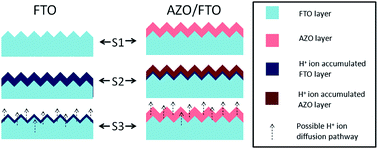Mechanism of an AZO-coated FTO film in improving the hydrogen plasma durability of transparent conducting oxide thin films for amorphous-silicon based tandem solar cells†
Abstract
An Al-doped ZnO (AZO)/F-doped SnO2 (FTO) film structure in an amorphous silicon solar cell (a-Si:H) was studied under exposure to hydrogen (H) plasma treatment via a simple spray pyrolysis. A radio-frequency magnetron sputtering method was used to deposit the FTO film first and the subsequent AZO overlayer on top of the FTO. The results of this approach suggest that the AZO film acts as a protection layer for the underlying FTO film and thus provides an excellent interface that protects the film from the direct bombardment with H+ ions and radicals. Even under exposure to H-plasma, the optical (


 Please wait while we load your content...
Please wait while we load your content...